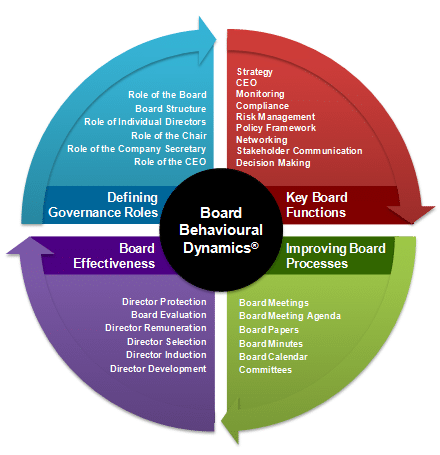Five Must-Know Things About Corporate Governance

If you’ve recently joined a board, or are thinking about doing so in the near future, you’ve probably heard the phrase Corporate Governance going around. If you’re like me, you have probably been perplexed as to what on earth this is.
At first Corporate Governance is a little tricky to get your mind around. So I’ve put together an introduction to Corporate Governance to help you start to understand this broad and all-encompassing term.
The information that follows is intended to be a peek behind the curtain; a little prompter to get you thinking and give you some direction when you start doing more research into corporate governance and what it means for you, your board, and the organisation.
Here are five must-know things about Corporate Governance for new and aspiring company directors.
1. What it is
Corporate governance broadly refers to the mechanisms, processes and relations by which corporations are controlled and directed¹.
Still confused? So I am!
In a nutshell, it’s the what and how a board controls and directs the organisation to ensure that it is achieving its strategic objectives while minimising risk and ensuring compliance of all relevant legislation and guidelines.
The physical representation of corporate governance mechanisms include policies, procedures, processes, standards, codes of conduct, internal auditing, and reports.
2. How you ‘use’ it as a director
Kiel, Nicholson, Tunny and Beck (2012, p. 7)² present a Corporate Governance Practice Framework (see below) that demonstrates five primary components of effective corporate governance at the board level.

This diagram provides a practical demonstration of governance at work on a board and as a director. It even incorporates the behavioural dynamics as a board, knowing that individual and group dynamics influence the performance and corporate governance practices of the director group.
This framework informs the corporate governance charter that the board choses to operate under, adapted to suit the unique needs and size of each organisation.
3. How it effects the business
The diagram above provides an indication of the ways that corporate governance can influence and effect business activity. For example, the board’s position on risk (namely, the risk comfort level of the board – AKA risk appetite – through being overly conservative or aggressive) can have a direct influence on strategic initiatives, investment activities, workplace practices, and staffing decisions.
As a director, you should develop an awareness of how governance decisions at the board level can impact – positively or negatively – other parts of the organisation.
4. Its relationship to culture
Culture is used to describe the – usually implicit – values, beliefs, and norms of an organisation. Think of it as “the way we do things around here” (Kiel et al, 2012, p. 334).
Corporate governance relies on culture to be effective: A conducive culture allows the board to feel confident that the staff of the organisation are carrying out their activities and making decisions in a manner that is in line with the corporate governance charter and associated policies, processes, practices, minimum standards, and risk management requirements.
5. There are best-practices to model your behaviour and corporate governance practices on
The great thing about corporate governance best practices is that there are many resources to consult and guidelines produced by some pretty top-notch governance specialists. This means that you don’t have to start from scratch or reinvent the wheel.
Here is a list for some places you can go to for help with developing corporate governance practices for your board and organisation:
- Book (I prefer to call it my board bible): Directors at Work: A Practical Guide for Boards by Kiel, Nicolson, Tunny, and Beck. Get it from Thomson Reuters here.
- ASX Governance Principles and Recommendations. Get it (free) online here.
- G20 / OECD Principles of Corporate Governance. Get them (free) online here.
- Governance for Good – The ACNC’s Guide for Charity Board Members. Access it (free) online here.
A quick Google search on “Governance Guides” will also provide you with a plethora of guides and other documents that you can use.
Use these guides as an indication for the highest corporate governance standards and distil the information down to a practical level that makes sense for the size, shape, and function of your board and organisation.
Now you should have a clearer vision of what corporate governance is, why it’s important, and how it impacts you as a director.
If this post has helped you, please feel free to share it with others you know who are a new or aspiring company director or board member. The more people who understand corporate governance, the stronger our boards and organisations will be.
